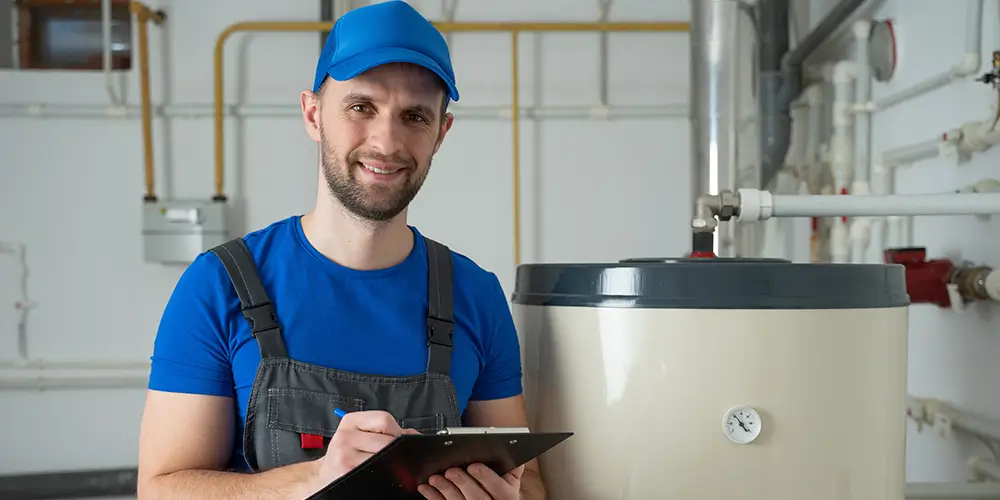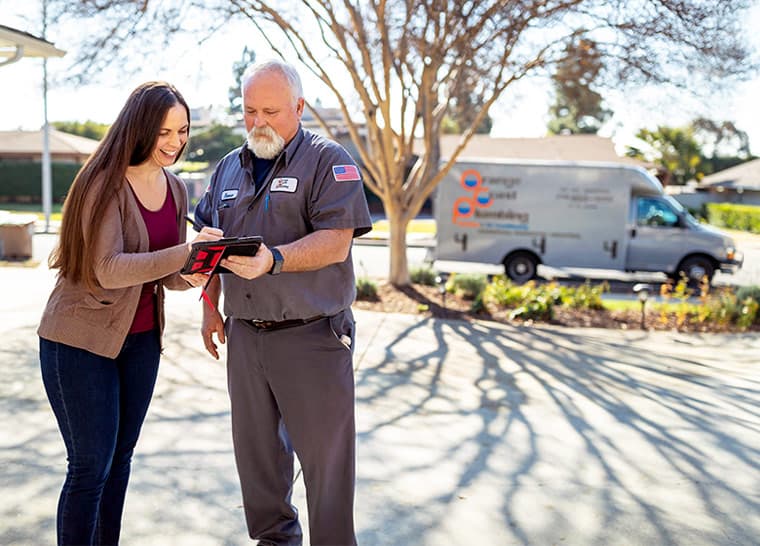Your plumbing system provides clean water and efficient waste removal — until something goes wrong.
The problems seem to come out of nowhere. A tiny slab leak bursts into a flood. A collapsed sewer line backs up every drain and toilet in the house, making it uninhabitable.
Yet even a pinhole leak in your slab foundation will offer warning signs, and drainage will slow in a sewer line long before the point of collapse.
Regular inspection of your plumbing system will help you catch many problems early. But you have to know where to look and what to fix. So here’s our easy-peasy DIY plumbing checklist to help you keep your pipes, drains, and fixtures trouble-free.
1. Inspect Your Water Heater
Check for signs of wear and tear, such as rust or leaks. Drain and flush your water heater at least once a year to remove sediment buildup; areas with hard water (like Orange County) may require more frequent flushing. Most standard water heaters last 10–15 years. If your water heater is approaching the limit, it may be time to shop for a new one.
2. Check Drain Pipes & Joints; Clean Your Drains
Look for symptoms of clogs or buildup, such as slow-draining sinks or toilets backing up. Use a plumber’s snake to clear out any stubborn clogs you can’t reach with a plunger. Inspect all pipes and fixtures for rust, corrosion, warping, or other damage. Apply hot water and a mild drain cleaning solution to remove any buildup or debris in your drains. Consider using drain screens to prevent hair and other debris from entering your drains.
3. Check Your Toilet for Leaks
Inspect the tank and bowl for leaks or cracks. Ensure the toilet is flushing correctly, and the water level is appropriate. Replace the flapper if it’s worn or cracked. Check the float ball and fill valve for proper operation. If you own an older toilet, consider upgrading to a newer, more efficient model.
4. Clean Out the Trap & P-Trap
The p-trap is a curved pipe that prevents sewer gases from entering your home. Remove debris from the trap and clear out clogs to keep your drains running smoothly.
5. Check Your Sewer Line
Inspect the clean-out pipe — the access point where you can use a plumber’s snake to clear out any blockages — at least once a year. If your home has an old sewer line, have a plumber inspect it with a video camera to detect leaks, small cracks, and root invasions before they become costly problems. As a precaution, hire a plumbing service for hydro jet cleaning every few years.
6. Test the Water Pressure
Turn on each faucet one at a time and note how quickly the water flows. If the water pressure is inconsistent in different locations, there could be an issue with the main water supply line or a clog in one of the pipes. You should also check if any faucets are leaking or if you hear any abnormal sounds coming from them.
Most hardware stores sell water pressure gauges for testing. The ideal home water pressure should be between 40 and 80 psi (pounds per square inch) with a steady flow rate of five to seven gallons per minute. Anything outside this range could indicate a blockage or leak. If you’re dissatisfied with your current water pressure, consider having a plumber inspect your system to identify potential problems.
7. Inspect Outdoor Pipes & Fixtures
Look for corrosion, leakage, or other damage in outdoor pipes and fixtures. Make sure any hoses you use are not leaking or damaged. Inspect all sprinkler systems for clogs or malfunctioning valves.
8. Check Around the Foundation
Cracks or a settling foundation can damage pipes and allow water to seep into the structure of your home. Water entering through cracked foundations can also cause mold growth, wall weakening, and more extensive interior damage.
Inspect your foundation regularly for signs of cracking or other structural damage. Look for warping, separation from the walls, white powdery residue (which may indicate moisture), and water pooling around the foundation.
If you suspect a problem with your foundation, call a plumber immediately to audit your pipes. Foundation repair can be expensive, but waiting too long can lead to flooding and render your home uninhabitable.
9. Check Your Faucets & Shower Heads
According to the Environmental Protection Agency (EPA), a leaky faucet dripping at one drip per second wastes more than 3,000 gallons of water annually.
Replace worn washers and check for corrosion around faucets and shower heads. Rusty spots may indicate corrosion in steel pipes, while green or white powdery residue may signal corrosion in copper.
Soak screens and aerators in white vinegar and scrub away any buildup. This will also increase the flow rate and reduce water consumption.
Conclusion
Regular inspection of your plumbing system can prevent expensive repairs and maintain efficiency in your home. Following this checklist will give you peace of mind that your plumbing is performing at its best.
If you spot a problem you can’t handle alone, contact a plumber immediately to repair any damage before it worsens. A $400 pipe replacement is far more affordable than a $4,000 slab leak repair.
And for any plumbing project around your home, don’t hesitate to contact Orange Coast Plumbing. From clogged drains to foundation repair and complete repiping, our certified experts can quickly identify and fix the problem.
FAQs: Your Plumbing Maintenance Checklist
Q: How often should I inspect my home’s plumbing system?
We recommend a DIY inspection at least twice yearly and a professional inspection annually to identify potential problems early.
Q: What’s the first sign of potential plumbing problems?
Signals include unusual noises, slow drains, unpleasant odors, or unexplained increases in water bills.
Q: How do I check for leaks in my plumbing?
Look for moisture or discoloration on walls, ceilings, and floors, especially around plumbing fixtures. Monitoring your water meter when all water is turned off can also indicate a leak.
Q: Can I fix a leaky faucet myself?
Most leaky faucets can be fixed by replacing the washer or cartridge inside the faucet handle. Always turn off the water supply before attempting repairs.
Q: What should I do to maintain my water heater?
Drain your water heater annually to remove sediment, check the pressure relief valve for proper operation, and inspect your water heater for leaks and corrosion.
Q: How can I prevent clogged drains?
Avoid flushing anything other than toilet paper and human waste down toilets. In kitchens, use sink strainers to catch food particles, and don’t pour grease down the drain.
Q: What tools should I have for essential plumbing maintenance?
Two plungers (one for the toilet, the other for drains), a pipe wrench, plumber’s tape, a drain snake, and screwdrivers are the tools you need for most DIY plumbing tasks and quick fixes.
Q: How can I maintain good water pressure in my home?
Clean faucet aerators and shower heads regularly to remove mineral buildup. Inspect your plumbing system for leaks that can compromise water pressure.
Q: How do I shut off the water supply in case of a major leak?
Locate the main shut-off valve for your home’s water supply and turn it clockwise to close it. You should know how to do this before an emergency happens.
Q: Can I unclog drains using chemical drain cleaners?
Chemical drain cleaners offer a quick fix but can damage pipes over time. For persistent clogs, it’s better to use a plunger or drain snake. If these methods fail, call a professional plumber.


